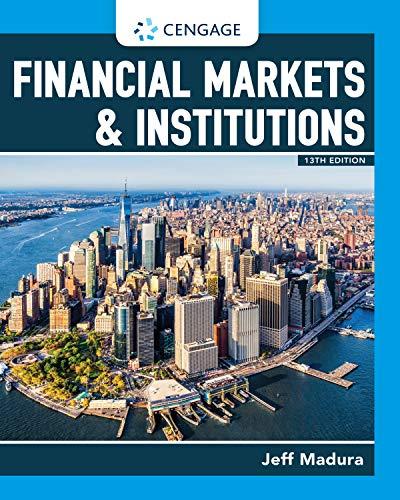Answered step by step
Verified Expert Solution
Question
1 Approved Answer
After consistently failing to win the lottery for several years, you notice the following article in the Wall Street Journal. Here's your chance to buy
After consistently failing to win the lottery for several years, you notice the
following article in the Wall Street Journal. Here's your chance to buy a lottery
ticket that is a guaranteed winner. But since it will apparently cost a bit over the
original $ ticket price, the winning ticket is considerably out of your price range.
The investment company you work for is however, interested in such
opportunities. You decide to research a bit further and gather the interest rate
data on the next page for the day before the ticket is auctioned. In your "first
cut" at the analysis, you decide to ignore taxes. The winner will receive the first
of the payments almost immediately, with the rest stretched out over years.
If you can purchase the ticket for $ million, what annual rate of return will you get on your
investment? What about if you win the bid at $ million?
Given the current July prices and yields in the capital markets, what do you think is the
approximate "fair market value" of the ticket?
If you factored taxes into this situation, how would it change your valuation of the ticket?
Tables for Problem # are extracted from
The Wall Street Journal, July
TREASURY BONDS, NOTES & BILLS
MORTGAGEBACKED SECURITIES
Representative Issues, quoted by Salomon Brothers Inc.
'Based on projections from Salomon's prepayment model, assuming interest
rates remain unchanged from current levels
Pricey, but Perhaps the Only Way
To Buy a Certain Lottery Winner
By ANDREA GERLIN
Staff Reporter of The Wall Street Journal
NEW YORK After the late Solomon
Keith bought a lottery ticket at the Chirag
Newsstand on Wall Street in his
number came up not once but twice.
Mr Keith won a $ million share of
a larger jackpot but didn't live to enjoy
much of it Unfortunately, the yearold
bank janitor died in an auto accident
months later, not long after collecting the
second of annual installments of $
each.
As a result, surrogate's court in lower
Manhattan will be the scene of some
unusual bidding tomorrow morning when
Mr Keith's $ million taxable lottery
proceeds the remainder after he and his
heirs collected five paymentsare offered
in an estate auction.
This time, the award will cost more
than the "dollar and a dream" advertised
by New York state's lottery. A minimum
bid of $ million has already been set in
this latest of gambles on interest rates.
Although the $ annual payments
may look attractive, wouldbe investors
should bear in mind that the end payment
in would have a net present value of
$ discounted at annually.
Charles Milo, an attorney involved
in the auction, declines to speculate about
whether the minimum bid is a bargain or
how much the prize may fetch. "That's for
each individual to calculate, depending on
what they think the future of interest rates
is going to be he says.
Using the year Treasury bond at
recent yields as a benchmark, a Wall
Street financial analyst predicts that the
successful bid is likely to hover around $
million. But if a bidder were to walk away
with rights to the payments in exchange
for the minimum $ million, the financial
analyst figures that the investor will have
parked the money in the equivalent of a
investment. And while that yield
would be high, the risk is low, because the
state isn't likely to default.
In the past, living prize winners have
sold their lottery futures in private auc
tions, but many states prohibit such trans
actions. New York state allows them only
with a judge's approval. A public estate
auction is even less common.
The lucky bidder will buy into an
exclusive club of grand prize winners.
Merely playing this game may require
membership in an exclusive club, though:
Bidders must present a certified or bank
check payable to the public administrator
of New York for $

Step by Step Solution
There are 3 Steps involved in it
Step: 1

Get Instant Access to Expert-Tailored Solutions
See step-by-step solutions with expert insights and AI powered tools for academic success
Step: 2

Step: 3

Ace Your Homework with AI
Get the answers you need in no time with our AI-driven, step-by-step assistance
Get Started


